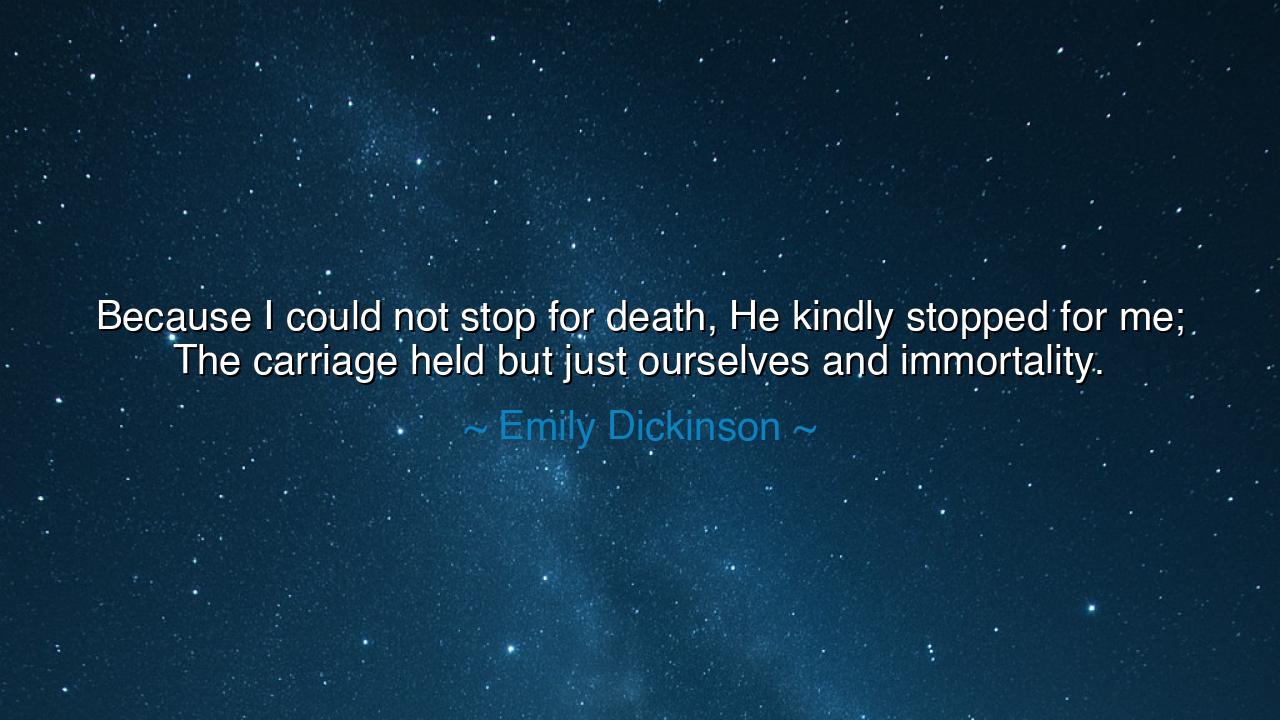
Because I could not stop for death, He kindly stopped for me; The
Because I could not stop for death, He kindly stopped for me; The carriage held but just ourselves and immortality.






When Emily Dickinson wrote, “Because I could not stop for death, He kindly stopped for me; The carriage held but just ourselves and immortality,” she gave voice to one of the most haunting and beautiful meditations on mortality ever conceived. In these words, death ceases to be a terror—it becomes a gentle companion, a courteous visitor who comes not with violence, but with grace. Dickinson’s poem transforms the great unknown into a familiar journey, where Death is not a destroyer but a guide, ushering the soul into eternity. In this delicate and mysterious image of the carriage ride, she captures the human condition in its entirety: our busy flight through life, our unpreparedness for the end, and the eternal truth that immortality awaits all who pass beyond the veil.
The origin of this quote lies within one of Dickinson’s most famous poems, written in the mid-19th century during her life of seclusion in Amherst, Massachusetts. A woman who lived much in solitude but thought deeply about the eternal, Dickinson often contemplated life, death, and the soul. Unlike many who feared death, she approached it with curiosity and calm, as if it were another dimension of existence rather than an end to it. The line “Because I could not stop for death” reflects humanity’s endless preoccupation with living—our ambitions, attachments, and desires—which keep us from pausing to consider our mortality. But Death, ever patient, does not wait for our convenience. He “kindly stops” for us, a reminder that death’s inevitability is not cruel, but natural, part of the great design of existence.
In describing death as kind, Dickinson removes its sting and replaces fear with serenity. Her carriage, drawn through the twilight of time, symbolizes the transition from the physical to the eternal. It carries only three passengers—the self, Death, and Immortality—for in that final journey, nothing else accompanies us. Not wealth, nor fame, nor even our dearest possessions. Only our soul, and that which it has become. The poet’s use of “immortality” as a presence in the carriage suggests that death is not an annihilation but a transformation, a crossing into a state beyond decay or change. Thus, Dickinson does not see life and death as opposites, but as partners in the same divine continuum, each completing the other.
This vision of death as a companion rather than an adversary echoes the wisdom of the ancients. The philosopher Socrates, on the eve of his execution, told his disciples that death was merely the separation of the soul from the body, and thus nothing to fear. To the Stoics, death was as natural as birth, to be met with acceptance, not dread. In Eastern philosophy, too, death is viewed not as destruction but as return—the wave receding into the ocean from which it came. Dickinson’s poem, written centuries later, stands as a poetic reflection of this timeless truth: that to live wisely is to live in peace with death. She invites us to see our end not as an intruder but as an inevitable guest whose arrival completes the journey we call life.
In life, we often flee from thoughts of our mortality, burying them beneath the noise of ambition, distraction, and desire. Yet Dickinson’s words remind us that to ignore death is to misunderstand life itself. She writes not to instill fear, but to awaken reverence. Just as we must learn to live deeply, we must also learn to die gracefully. The modern world, obsessed with speed and consumption, has lost this wisdom. We rush endlessly forward, as if the finish line does not exist. But when the “carriage” finally arrives—quiet, patient, unstoppable—no amount of running can delay it. The question, then, is not if death will come, but how we will greet it when it does.
Consider the example of Mahatma Gandhi, who, like Dickinson, lived with the awareness that life and death are but two faces of truth. Gandhi often said, “Live as if you were to die tomorrow; learn as if you were to live forever.” When he met his death through an assassin’s bullet, witnesses said he fell with the words “He Ram”—a prayer on his lips, peace in his eyes. Like Dickinson’s traveler in the carriage, he met death not as a foe, but as an old acquaintance, an inevitable companion on the journey to immortality. His life, like hers, was a testament to the strength that comes from acceptance rather than denial.
Thus, my children of the fleeting dawn, learn from Emily Dickinson’s wisdom. Do not flee from death, but neither should you seek it. Instead, live so wholly, so truthfully, that when death “kindly stops” for you, you may step into that carriage without regret. Speak your love, share your gifts, forgive your wounds, and build a life worthy of remembrance. For in the end, immortality is not found only beyond the grave—it is also written in the legacy of the heart. When death’s carriage arrives, let it find you not clinging in terror, but seated in grace, ready to journey forward with dignity, peace, and eternal wonder.






AAdministratorAdministrator
Welcome, honored guests. Please leave a comment, we will respond soon